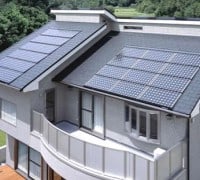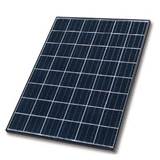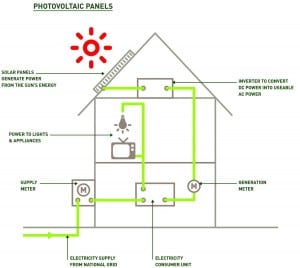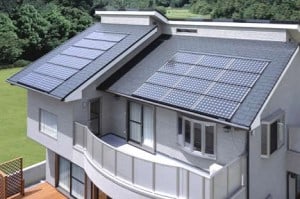
There are many factors to consider in evaluating a solar energy application for a small scale installation such as residential homes and light commercial purposes. The matrix of variables can boggle the mind, leaving the consumer with more questions than before they started. We will start with a little history and a description of the basic solar energy options available in the market today.
The solar energy basic principles have been around for thousands of years dating back to the 7th Century BC, when man discovered the prism light effects of producing heat. In modern times we associate solar energy with solar panels, wind power and geothermal applications. The 1970’s is credited with establishing the commercial footprint for today’s methods of harnessing solar power. That was the decade when the US Department of Energy established the Solar Energy Research Institute and photovoltaic (PV) manufacturing production produced 500 kilowatts. During this period the first completely solar powered residential home was produced.

It is common by today’s standards to think of solar powered energy as an array of black panels that are mounted on roof tops throughout the nation. Although there is growing interest in solar water heating and geothermal applications, we will focus on PV panels systems. So what is a PV panel and how does it produce energy you ask? The non technical explanation is that a photovoltaic panel commonly comes in a rectangular shape approximately 3’x 5’x 1″ (varies) and consist of a black glass face covering small copper circuitry (conductor) producing a direct current (DC) of energy.
This direct current of energy is then transferred to a device that converts DC to AC energy, which we use in our homes as electricity. A common PV panel will produce anywhere from 200kw to 500kw each. Panels are assembled in groups, called solar arrays and produce collectively much larger quantities of electricity for larger amounts of immediate consumption. To build a reserve of electrical power a system requires a battery storage component to the entire system. For the purposes of this paper, we will only focus on
Residential electricity consumption only represents about 10% of total US electrical consumption annual according to US Energy Information Administration. Of this 10%, renewable energy represents approximately 8% of all energy produced. So as you can see, solar energy is not widely used as a source of electricity by US households. Even more interesting is that the demand for household solar energy only represents less than 1% of total electricity produced. There are many factors that contribute to this result, alternative energy commodities prices, investment required to own a solar system and the fact of so many other energy sources. Needless to say the solar power industry has a real challenge competing with crude oil, natural gas and coal, which are the principle commodities used in producing 93% of the total amount of energy produced in the US.
There are a few different options available to homeowners to purchase and consume solar energy. The easiest of all the options is to purchase solar power directly through your electrical provider. You are likely to pay a premium over more conventional electrical sources. The more common options involve the actual purchase and installation of a solar panel system mounted directly to your home. Most PV systems are mounted to the southern facing roof surface of the house, but they can also be ground mounted through systems that are weighted down or through mounting the panels on steel poles. The roof mounted systems are most commonly used and are directly fastened to the structural members of the homes roof system. This is important due to the uplift pressures imposed by high winds. If not properly mounted the system could be found in your neighbors pool after a large storm.
The critical factors of installing a solar system on your home is that it is essential to have direct southern exposure to the sun from the actual mounting surface without shading interferences. Secondly that the solar system production of electricity is designed around the total consumption of the homes energy demands. That is to say, that if you are consuming 2,000 kilowatts in the summer and 1,000 kilowatts in the winter, you would be best served to build the system to produce 1,000 kilowatts. Your service provider will only pay you for half the price to buy your excess electricity as they would to sell you your electricity. It is important to understand this when evaluating the payback period for the cost of the entire system installed.
Solar power has moved from an expensive futuristic idea to an affordable practical plan over the last 10 years. The price of PV panels has dramatically dropped during this period making residential solar systems more affordable. The price range usually depends upon the actual size (kilowatt output) of your system and the distances to the electrical metering. A common price range for a home consuming 1,000 – 2,000 kw monthly would be $3,000 – $10,000 gross amount. These total cost are often offset by tax credits and rebates to determine the adjusted gross installation price. To establish your net installation price, you are required to estimate the actual amount of electricity produced from your new solar system in a year’s period and subtract this amount from your total estimated cost of electricity for the year. Take the annual cost savings and divide it into the actual adjusted gross amount paid for the system. This will provide you with the total number of years before the system pays for itself, provided there are not interruptions in the system caused by equipment malfunctions or poor installation methods.
The cost benefits of solar energy to a homeowner are determined by the cost and consumption of electricity. Living in the southern parts of the US typically requires air conditioning, which is the largest component user of electricity in the home. Most homes in the northern portion of the US use fossil fuels for heating in the winter. So unless they are using electricity for heating, their consumption of electricity is less than half that of southern states .
In California, the price of electricity is double to triple the cost in Texas. It is very common in California for the solar system financial payback for a well designed and properly installed home’s solar system to be as little as 5 years. Where as in the state of Texas, the same solar system could be a 10 – 18 year payback. From a ROI stand point, a 5 year payback is considered a sound investment and worth all the benefits that solar can provide. Where as a 15 – 18 year payback becomes extremely unfavorable considering that most PV manufactures only warrant their solar panels for 25 years. Another drawback with roof mounted solar systems is that most homes use composite asphalt shingles on their homes roof. The typical asphalt composite roof system commonly does not even provide 25 years of service. So the homeowner is required to remove the solar system and then reinstall the same system every time they re-shingle their roofs. This is often a significant cost that does not get calculated into the total cost of the initial solar project.
Many solar system project purchase decisions are not made on strictly financial matters, but rather on the environmental benefits or problems resulting from lack of reliability of the buyers electrical power grid. There are many non financial reasons that homeowners are motivated to design and install a solar system for their homes. In most all these cases the homeowner plans on staying in their home for an extended period of time. Solar systems do not always translate into equal resale value when selling your property. Without a commitment to an extended period of stay, a solar system for your home could turn out to be a questionable financial decision in hindsight.
Solar energy most certainly plays a role in the nation’s future energy needs. The falling cost of solar components will greatly make solar a real energy alternative in the years ahead. Unfortunately for this industry sector crude oil prices have sharply reduced as a result of rising crude inventory levels. Until there is a reversal of these trends, solar power demand will be low to moderate by most US households.
For more information on value engineering a photovoltaic energy system for your home contact home remodeling contractor Houston,TX contact @ info@marwoodconstruction.com or call 713-818-1720.












